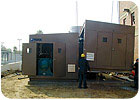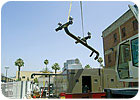
This photo shows the setting of the second half of the chiller module. Each section came with the chillers installed, chilled water pumps, VFDs, and electrical panels.
To maintain performance for the guests who check in, this historical landmark had to arrange for its chiller plant to check out - not just entailing a retrofit, but including a shift in location away from the traditional hotel grounds. See how the new plant and its controls have boosted efficiency, and why the move also helped the hotel stop blowing fuses at special events.
Guests of the 132-year-old Mission Inn Hotel & Spa in Riverside, CA, remained cool and comfortable over the summer, and there was reliable power behind the hotel’s spectacular winter Festival of Lights. The thanks go to the July 2007 completion of a design-build project that replaced the existing 350-ton central chiller plant with a more efficient 600-ton modular plant and additional power capacity for future electrical requirements.
The freestanding central plant and associated power upgrade will enable the Mission Inn Hotel and Spa to move forward with any future property enhancements. Moreover, through a working partnership with the City of Riverside, EMCOR Services Mesa Energy Systems, Inc., the prime contractor, was able to complete the project within half the time ordinarily required for a project of this scope, including development and approval of an architectural solution that met the criteria of the city’s Historic Preservation Program.
A National Historic Landmark, the Mission Inn is a unique luxury hotel in downtown Riverside. From its modest beginnings in 1876 as a two-story, 12-room adobe boarding house, the property has been expanded over the course of 132 years with the addition of multiple wings influenced by the architectural styles of many cultures, from the New World to the Far East. Public spaces, guest rooms, and suites are decorated with opulent finishes and furnishings. These include a chapel designed to accommodate a massive 18th-century gold-leafed cedar altar from Mexico and seven Louis C. Tiffany stained glass windows.
Today the Mission Inn Hotel & Spa occupies an entire city block, and it comprises 239 guest rooms, including 28 suites; 20,000 sq ft of meeting and banquet space; 5,000 sq ft of outdoor patio space; a full-service spa; four restaurants; and a cocktail lounge. The hotel presents Riverside’s annual Festival of Lights from Thanksgiving to New Year’s Day, which is a major attraction for visitors.

To meet the demands of the schedule the piping, valves, flanges, and welding were completed on the ground. The pipe was lifted in place, set on pipe supports and bolted to the equipment via the flanges at each inlet or outlet.
A Growing Need for Capacity
A previous study of the existing conditions and proposed construction projects concluded that major components of the existing 350-ton central chiller plant within the hotel complex could not adequately satisfy the 405-ton chilled water cooling load of the hotel during the peak summer months, much less the projected 510-ton combined cooling loads of new restaurants, kitchens, a spa, and a computer server room. Similarly, projected future condenser water loads of 357 tons exceeded available condenser water capacity by 72 tons. In addition, the projected loads far exceeded the associated future heat rejection capacity of the existing cooling tower. The engineering study provided a conceptual design of a new central plant.In January 2007, Mission Inn selected EMCOR Services Mesa Energy Systems, Inc. to furnish, design, and install the new plant based on the original study. Not only had Mesa performed the maintenance on the existing plant for many years, but as a D-B firm, Mesa was able to offer broader options, based on the inn’s projected load profile, as compared with the single-source solutions proposed by two HVAC manufacturers.

This photo depicts the installation of the pipe. Only one tower was available at the time, with the isolation valves installed and connected to the second tower time when it was available to set.
A Modular Solution
A modular solution was selected for two main reasons: the fast-track nature of the project and the unique site. Given that the site is located in a historic area of Riverside, Mesa consulted with the City of Riverside’s Historic Preservation Office and worked with an independent architect, Diane White, to identify a solution with an aesthetically compatible design. It was also necessary to design the layout of the central plant to maintain a small footprint, reserving the most land possible for future expansion of the innís annex. The modular solution helped meet both objectives. And, thanks to the partnering relationship, the usual six-week historical review process was completed in less than two weeks.Mesa specified a modular central plant with remote cooling tower to be pre-built by the manufacturer, shipped in two sections, and bolted together at the rear of the annex site and adjacent parking garage deck.
The selected systems inlcude the following components:
- Modular central plant with a total capacity of 600 tons consisting of two centrifugal water cooled chillers with factory-mounted variable-flow drives;
- Two new stainless steel induced draft counter-flow design, two-cell cooling towers designed to cool 2,000 gpm of water (from 95°F to 85° at 74° entering wetbulb temperature, and VSDs for the fans;
- Three frame-mounted, end-suction primary chilled water pumps and two frame-mounted, end-suction condenser water pumps, all with VSDs;
- Cooling tower filtration and chemical feed system;
- Chilled water system expansion tank and air separator;
- Two electric fancoil units for central plant A/C;
- Ventilation fan with gravity back-draft damper sized for refrigerant evacuation per ASHRAE 15;
- Central plant refrigerant monitoring system;
- Magnetic flow meter for flow monitoring of main chilled water distribution;
- Six automated isolation control valves.
Aiming for an Energy Star Rating
Even with the additional capacity, power usage will still be less than the existing plant due to built-in redundancy and the fact that VSD technology dramatically reduces consumption at lower loads. In addition, the counter-flow cooling towers use up to 45% less water than the existing system. In another improvement, the addition of a side-stream separator keeps the condenser water cleaner.The system also uses R-134A refrigerant, which meets the USGBC’s LEED® certification standard. As part of its continuing maintenance contract, Mesa will benchmark the performance of the new system. The innís goal is to eventually achieve the Energy Star Rating, and to implement an ongoing program to reduce both water and electrical consumption.
A Cost-effective Communication Protocol
The central plant’s existing DDC system was expanded to control and stage the new chillers, pumps, and cooling tower fans. The central plant DDC controller resides at the module with network connection to the existing system at the decommissioned existing central plant location in the hotel complex, approximately 200 ft from the new central plant.A BACnet system was recommended. In this case, rather than having to pull wire from all components back to the main controller, wire is pulled to the closest controller, and BACnet relays the information throughout the system. More and more of the control systems installed by Mesa now use this protocol.
More Power to Them
According to an electrical study of the complex, the Mission Inn was also underpowered. Of course, the study only confirmed what the owner already knew from experience: for example, the inn was blowing circuits every year during the annual Festival of Lights. Elimination of the central plant within the hotel complex, along with its associated power requirements, restored approximately 600 A for use in the hotel for lighting and other power requirements.As part of this project, Mesa worked with Riverside Public Utilities to bring in 3,000A of new 460V power to the central plant; 1,500 A to serve the new central plant and the parking garage, and the remaining 1,500 A for future hotel requirements. A sister company, Dynalectric, performed the electrical work.
General contracting activities included laying the required footings, the slab-on-grade foundation, and an equipment pad for Riverside Public Utilities’ transformer and associated switch gear, and plumbing for makeup and drain systems.
Additional mechanical system contracting activities included provision for trenching, including required break, removal, excavation, backfill, and paving from the central plant to the existing point of connections (POC) at the old chiller plant. The existing tunnel was utilized for the new chilled water piping to the POC. Aboveground, chilled water piping was installed from the new chiller plant to the POC. Condenser water supply and return piping was installed to connect to the new cooling tower system. The modular central plant was completed with piping for chilled water, fancoil units, and water treatment equipment.
The shutdown of the existing central plant and cutover to the plant was scheduled for an evening in June. Crossover piping had already been laid to transfer the plant into the existing piping, making it a smooth transition.
Throughout the project, minimizing the impact of the work on the Inn’s guests, as well as the other businesses in the area, was a priority. Coordination, cooperation, and detailed planning were essential in meeting that goal. As working partners in the project, the owner, Mesa, the City of Riverside and Riverside Public Utilities, the architect, and subcontractors were on a mission to complete the project in time for the peak cooling season, and the fast-track project drew to a successful close.ES
